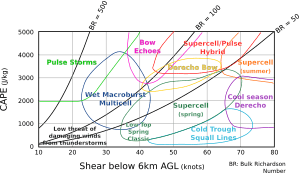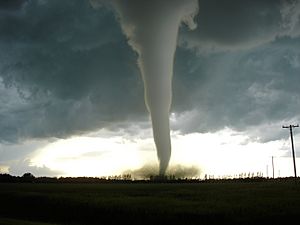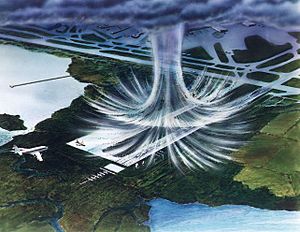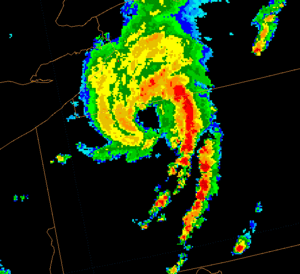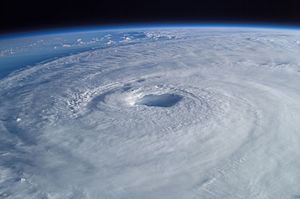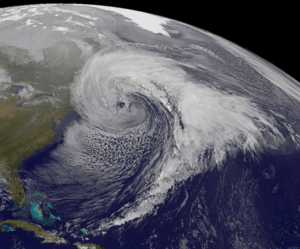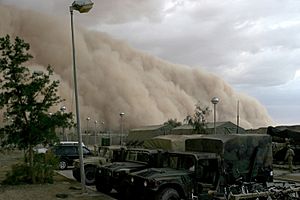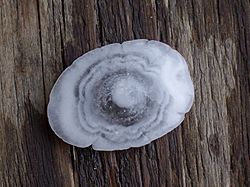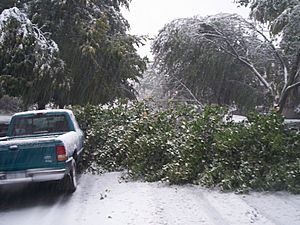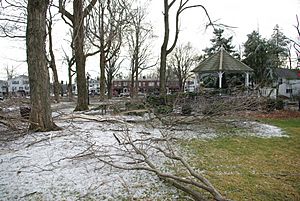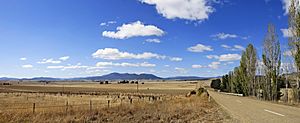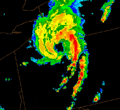Severe weather facts for kids
Severe weather is any dangerous weather event that can cause damage, disrupt daily life, or harm people. The types of severe weather depend on where you are, how high up you are, the land's shape, and the air conditions.
Strong winds, hail, heavy rain, and wildfires are all forms of severe weather. So are thunderstorms, downbursts, tornadoes, waterspouts, and large storms like tropical and extratropical cyclones. Some regional and seasonal severe weather includes blizzards (snowstorms), ice storms, and dust storms. Extreme weather, like very hot or cold periods, or droughts, can also lead to severe weather events. Climate change is also affecting how often and how strong severe weather happens.
Contents
What Does "Severe Weather" Mean?
Weather experts usually call any weather that puts lives or property at risk, or needs help from authorities, "severe weather." A more specific meaning of "severe weather" refers to events linked to strong thunderstorms.
The World Meteorological Organization (WMO) divides severe weather into two groups:
- General severe weather: These events cover large areas. Examples include big European wind storms.
- Localized severe weather: These events affect smaller areas. Downbursts and tornadoes are examples.
It's important to know that "severe weather" is not exactly the same as "extreme weather." Extreme weather describes unusual weather events that are very different from what's normally expected in an area.
How Does Severe Weather Happen?
Severe weather forms from the same things that create regular thunderstorms: moisture in the air, rising air (often from warm air currents), and unstable air. Many different conditions can turn a normal thunderstorm into a severe one.
For example, a layer of cold air high up can help create large hail in a storm that otherwise looks harmless. The most dangerous hail and tornadoes often come from special storms called supercell thunderstorms. The worst downbursts and straight-line winds (called derechos) come from storms shaped like a bow. Both these storm types usually form where winds change a lot with height.
Floods, hurricanes, tornadoes, and thunderstorms are some of the most damaging weather events. Even though they are all linked to cumulonimbus clouds (thunderclouds), they form in different ways and places. Scientists use this information to create computer models to predict where and when these events might happen. This helps warn people and save lives.
Types of Severe Thunderstorms
Severe thunderstorms are put into three groups: "approaching severe," "severe," and "significantly severe."
- Approaching severe: This means hail is between 1/2 to 1 inch (1.3 to 2.5 cm) wide, or winds are between 50 and 58 mph (80–93 km/h). In the United States, these storms might get a special alert.
- Severe: This means hail is 1 to 2 inches (2.5 to 5 cm) wide, winds are 58 to 75 mph (93–121 km/h), or there's a weak tornado (F1 strength).
- Significant severe: This means hail is 2 inches (5 cm) or wider, winds are 75 mph (120 km/h) or more, or there's a strong tornado (EF2 or stronger).
Both "severe" and "significant severe" storms usually lead to a severe thunderstorm warning from weather services in countries like the United States, Canada, and Australia. If a tornado is seen or is about to happen, the severe thunderstorm warning is replaced by a tornado warning.
A "severe weather outbreak" usually means ten or more tornadoes, some of them strong and long-lasting, plus many reports of large hail or damaging winds, happening over one or more days. The size of the affected area also matters.
High Winds
Strong winds can cause a lot of damage, depending on how fast they blow.
Winds as slow as 26 mph (42 km/h) can cause power outages if tree branches fall onto power lines. Some trees are more likely to break or fall in strong winds.
Very strong winds, like those from hurricanes, thunderstorms, derechos, or tornadoes, can destroy mobile homes and damage buildings. Winds this strong can even shatter windows and strip paint from cars.
When winds go over 155 mph (250 km/h) in strong tropical cyclones or tornadoes, homes can completely collapse. Major damage happens to larger buildings. Total destruction of man-made structures occurs when winds reach 200 mph (320 km/h). Scales like the Saffir–Simpson Hurricane Scale for cyclones and the Enhanced Fujita scale for tornadoes help estimate wind speed based on the damage they cause.
Tornadoes
A tornado is a dangerous spinning column of air. It touches both the ground and the bottom of a thundercloud (or sometimes a cumulus cloud). Tornadoes come in many sizes. They usually have a visible funnel cloud that reaches the ground, surrounded by a cloud of dirt and debris.
Tornado winds usually range from 40 mph (64 km/h) to 110 mph (177 km/h). They are typically about 250 feet (76 meters) wide and travel a few miles before fading away. Some tornadoes can have winds over 300 mph (480 km/h), be more than two miles (3.2 km) wide, and stay on the ground for dozens of miles. The Enhanced Fujita Scale and the TORRO Scale are used to measure a tornado's strength and the damage it causes.
Tornadoes are very destructive but usually don't last long. Most last less than an hour, but some have lasted two hours or more. Because they are so short-lived, scientists are still learning a lot about how they form.
Waterspouts
Waterspouts are generally tornadoes or similar spinning storms that form over water.
Waterspouts usually don't cause much damage because they are over open water. However, they can move onto land. If they do, they can damage plants, weak buildings, and other structures. Waterspouts usually don't last long over land because the ground's friction makes their winds disappear quickly. While not as dangerous as "classic" tornadoes, waterspouts can flip boats and cause serious damage to larger ships.
Downbursts and Derechos
Downbursts happen inside thunderstorms when a lot of rain-cooled air rushes down. When this air hits the ground, it spreads out in all directions, causing strong winds. Unlike a tornado, the winds in a downburst do not spin; they blow straight outwards.
"Dry downbursts" happen with thunderstorms that have little rain. "Wet downbursts" come from storms with heavy rain. Microbursts are small downbursts, with winds spreading up to 2.5 miles (4 km). Macrobursts are larger, with winds spreading more than 2.5 miles (4 km). A "heat burst" is a rare type that causes temperatures to rise sharply because there's no rain to cool the air.
Derechos are long, often stronger, forms of downburst winds. They are known for causing widespread straight-line wind damage.
Downbursts can create sudden changes in wind direction and speed, which are very dangerous for airplanes. These powerful downbursts can cause damaging winds that last 5 to 30 minutes, with speeds as high as 193 km/h (120 mph). They can cause damage similar to a tornado. Downbursts happen much more often than tornadoes.
Squall Lines
A squall line is a long line of severe thunderstorms that can form along or ahead of a cold front. Squall lines often bring heavy rain, hail, frequent lightning, strong straight-line winds, and sometimes tornadoes or waterspouts. You can expect strong straight-line winds where the squall line forms a "bow echo" shape. Tornadoes can sometimes form along waves within the line. Very strong bow echoes that cause a lot of wind damage are called derechos.
Squall lines are a common cause of straight-line wind damage. Most wind damage that isn't from a tornado comes from squall lines. While the main danger is straight-line winds, some squall lines can also produce weak tornadoes.
Tropical Cyclones
Very high winds can come from mature tropical cyclones. These storms are called hurricanes in the United States and Canada, and typhoons in eastern Asia. The strong winds from a tropical cyclone can create huge waves that harm sea life near the surface, like coral reefs.
Coastal areas can get a lot of damage from a tropical cyclone's strong winds. However, inland areas are usually safer from the winds because they weaken quickly over land. But heavy rain from tropical cyclones can cause severe flooding even far inland.
Strong Extratropical Cyclones
Severe local windstorms in Europe often develop from winds coming off the North Atlantic Ocean. These storms are usually linked to powerful extratropical cyclones and their weather fronts. European windstorms mostly happen in autumn and winter and often bring heavy rain.
A large storm along the East Coast of the United States and Atlantic Canada is called a Nor'easter. They get their name because their winds come from the northeast, especially in coastal areas. A Nor'easter is a low-pressure system whose center is just off the East Coast. Its winds on the front left side blow onto land from the northeast. Nor'easters can cause coastal flooding, coastal erosion, heavy rain or snow, and winds as strong as a hurricane. They can happen any time of year but are best known for winter storms.
Dust Storms
A dust storm is a type of windstorm with large amounts of sand and dust carried by the wind. Dust storms often happen during droughts or in dry and semi-dry regions.
Dust storms are very dangerous and can even cause deaths. They can reduce visibility a lot, making it risky for cars and planes. The tiny particles can also make it hard to breathe and harm your eyes.
Dust storms also cause many problems for farming. Soil erosion is common, which reduces good land for growing crops. Dust and sand can also wear down buildings and rocks. Nearby water bodies can get polluted by settling dust, harming aquatic life. Less sunlight can affect plant growth, and less infrared radiation can cause temperatures to drop.
Wildfires
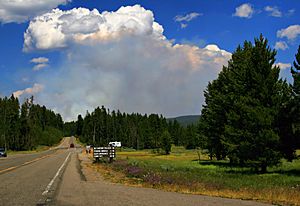
The most common cause of wildfires changes around the world. In the United States, Canada, and Northwest China, lightning is the main cause. In other parts of the world, human activities are a big factor. For example, in Mexico, Central America, South America, Africa, and Southeast Asia, wildfires can be caused by farming, raising animals, and clearing land by burning. Human carelessness, like machinery sparks or cigarette butts, also causes many wildfires.
Wildfires spread very quickly when burning through thick, unbroken plants. They can move as fast as 10.8 km/h (6.7 mph) in forests and 22 km/h (14 mph) in grasslands. Wildfires can also spread by "jumping" or "spotting." This happens when winds and rising air carry hot embers and burning materials over roads, rivers, or other barriers. These embers can start new fires downwind from the main fire. In Australian bushfires, new fires can start as far as 10 km (6 miles) away from the main fire. Since the mid-1980s, earlier snowmelt and warmer temperatures have also led to longer and more severe wildfire seasons in the Western United States.
Hail
A hailstorm is any thunderstorm that produces hailstones. Hailstorms can happen anywhere there are thunderclouds, but they are most common in tropical and monsoon areas. Inside thunderclouds, strong updrafts (air moving up) and downdrafts (air moving down) cause water droplets to freeze and grow into hailstones. When they get heavy enough, they fall to the ground. The downdrafts can also make the hailstones fall faster. The term "hailstorm" is usually used when there are a lot of hailstones or they are very large.
Hailstones can cause serious damage, especially to cars, airplanes, skylights, glass roofs, livestock, and crops. Rarely, very large hailstones have caused head injuries or even deaths. Hailstorms have caused costly and deadly events throughout history. The largest hailstone ever recorded in the United States fell in 2003 in Aurora, Nebraska. It was 7 inches (18 cm) wide and 18.75 inches (47.6 cm) around.
Heavy Rainfall and Flooding
Heavy rainfall can lead to many dangers, mostly floods. Flooding is when areas that are usually dry become covered in water. There are three main types:
- River flooding: When rivers overflow their banks.
- Flash flooding: When an area, often in cities or dry places, floods very quickly.
- Coastal flooding: Caused by strong winds from tropical or other large storms.
Heavy rains often happen when a lot of moisture in the air is directed by a weather system. Flash flooding can happen quickly with slow-moving thunderstorms and their heavy rain. It's most common in cities because there are fewer plants and water bodies to soak up the extra water. Flash floods can damage small bridges and weak buildings. They can destroy plants and crops. Cars can be swept away. Soil erosion can also happen, leading to landslides. Like all floods, flash flooding can spread diseases carried by water or insects. Flash flooding can also be caused by heavy rain from tropical cyclones or by ice dams suddenly melting.
Monsoons
Monsoons are seasonal wind shifts that bring long periods of rain, creating wet seasons. These happen in places like Southeast Asia, Australia, and parts of Africa and South America. If the rainfall is too much, widespread flooding can occur, leading to landslides and mudflows in mountains. Rivers can overflow, submerging nearby buildings. Flooding can be worse if there were fires during the previous dry season, as the soil might then repel water.
Governments help people deal with monsoon floods by mapping flood-prone areas and giving advice on how to control erosion.
Floodwaters during monsoon seasons can contain many tiny living things like bacteria and viruses. Mosquitoes and flies lay eggs in contaminated water. These can cause foodborne and waterborne diseases like malaria, cholera, typhoid, and hepatitis A. People exposed to floodwaters for a long time can also get infections like trenchfoot.
Tropical Cyclones (Heavy Rain)
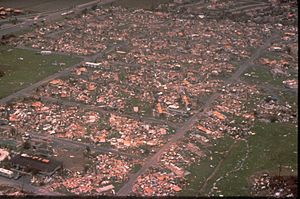
A tropical cyclone is a fast-spinning storm system with a low-pressure center, strong winds, and spiraling thunderstorms that bring heavy rain. It gets its energy from the heat released when moist air rises and its water vapor turns into liquid. Tropical cyclones can cause huge amounts of rain, high waves, and damaging storm surges. The heavy rains lead to significant flooding far inland. Storm surges can cause widespread coastal flooding up to 40 km (25 miles) from the coast.
Even though cyclones cause a lot of damage, they are also important for bringing much-needed rain to dry regions. Areas in their path can get a year's worth of rain from one tropical cyclone. They also help move heat and energy from the tropics towards cooler areas, which is important for Earth's overall weather system.
Severe Winter Weather
Heavy Snowfall
When large amounts of heavy, wet snow fall, it can cause a lot of damage, similar to strong tropical cyclones. If the snow is very heavy (more than 50 kg/m² or 10 pounds per square foot), it can pile up on trees and power lines, causing them to break.
An avalanche happens when a sudden impact or change causes a large amount of snow on a mountain to rush downhill. Before an avalanche, there's often a strong wind caused by the avalanche itself, which adds to its destructive power. A lot of snow on top of buildings can make them collapse. When snow melts, acidic rain that was trapped in the snow can be released and harm marine life.
Lake-effect snow forms in winter when cold winds blow over long stretches of warmer lake water. The lake water provides energy and moisture, which then freezes and falls as snow on the downwind side of the lake.
Blizzards often have a lot of blowing snow and strong winds, which can make it very hard to see. This can cause people to get lost or be exposed to the cold for too long. The strong winds in blizzards create a wind chill that can lead to frostbite and hypothermia. Blizzards can also damage plants, cause power outages, freeze pipes, and cut off fuel lines.
Ice Storms
Ice storms are also called "Silver storms" because of the icy coating they create. They happen when rain falls but freezes as soon as it hits cold surfaces, building up a thick layer of ice.
The ice that builds up during an ice storm can be extremely destructive. Trees and plants can be destroyed, which can then bring down power lines, causing loss of heat and communication. Building roofs and cars can be severely damaged. Gas pipes can freeze or break, causing gas leaks. The extra weight of the ice can also lead to avalanches. Visibility can become very poor. After an ice storm, sudden melting can cause severe flooding, especially near lakes and rivers.
Heat and Drought
Drought
Another type of severe weather is drought, which is a long period of very dry weather with little or no rain. Even though droughts don't develop as quickly as other severe weather, their effects can be just as deadly. Droughts are measured by the problems they cause.
Droughts have many severe effects. They can cause crops to fail and greatly reduce water supplies, sometimes affecting human life. A drought in the 1930s, known as the Dust Bowl, affected 50 million acres of farmland in the central United States. In terms of money, droughts can cost billions of dollars. For example, a drought in the United States in 1988 caused over $40 billion in losses. Besides other severe effects, the dry conditions from droughts also greatly increase the risk of wildfires.
Heat Waves
While official definitions vary, a heat wave is generally a long period of very hot weather. Even though heat waves don't cause as much money damage as other severe weather, they are extremely dangerous to people and animals. According to the United States National Weather Service, the average number of heat-related deaths each year is higher than the total deaths from floods, tornadoes, lightning, and hurricanes combined. In Australia, heat waves cause more deaths than any other type of severe weather. Like in droughts, plants can also be badly affected by heat waves (which often come with dry conditions) and can lose their moisture and die. Heat waves are often more dangerous when combined with high humidity.
See also
 In Spanish: Clima extremo para niños
In Spanish: Clima extremo para niños
- List of severe weather phenomena
- Storm chasing
Images for kids
-
Cyclonic vortex over Pennsylvania with a trailing squall line


